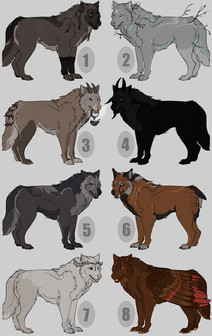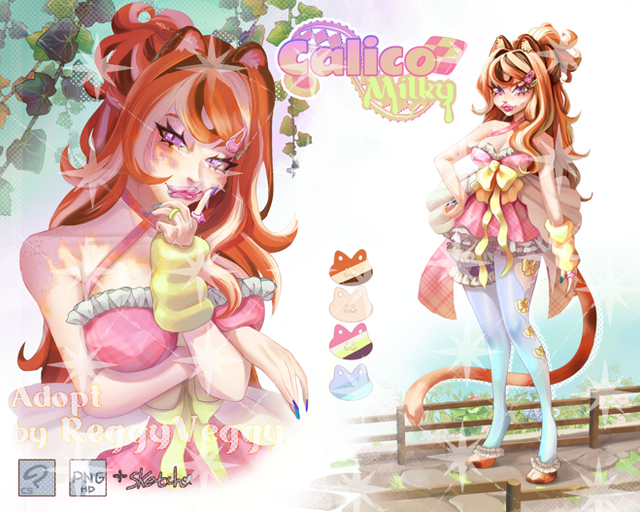HOME | DD
 ShockTherapyStables — Tutorial - Dilutes in Dogs
ShockTherapyStables — Tutorial - Dilutes in Dogs

Published: 2013-04-21 19:22:39 +0000 UTC; Views: 30708; Favourites: 1275; Downloads: 250
Redirect to original
Description
A lot of people in our latest poll asked for tutorials about coloring and markings. We'll be addressing some of the more common coloring mistakes we see, and decided to start with a topic that a lot of people seem to have trouble with: dilutes. Dilutes are a simple mechanic once you know how they work, but if you don't know then they can appear very complex. We hope this tutorial is useful if you want to figure out how to incorporate dilutes into your DARPG art! Also a small section on Merles as well.(Of course, you do not ALWAYS have to follow this tutorial. If you're content with not paying any mind to genetics when you design dogs, that is entirely your choice and you're free to do as you like. But, it never hurts to know!)(
Next tutorial will be all about brindle







Enjoy! Please feel free to leave us any feedback or questions you might have.
Other STS Tutorials: Brindle
Art and Characters (Hera, Uno, Artemis, Whiteface, Castiel, Trinity) © *ShockTherapyStables
Characters (Daeymon, Kaisen) © ~MixedBagKennel and *samuRAI-same
Related content
Comments: 195

She does have very bright, almost golden eyes, especially considering the last lab we owned, who was black as black can be. As for fading, I would be inclined to go with that, but she's very young (she just turned 1 last week). Is it possible for a dog to be born black (or at least very dark) but change colour into the first few years of life? (similarly to how eye colour changes on humans as well as dogs after birth)
Thanks so much for the quick response, it's very appreciated!
👍: 0 ⏩: 1

There is a genetic factor called Seal that sometimes crops up in black dogs that causes slight browning/fading on the flanks and undersides, I haven't heard of it happening in Labradors but I haven't done much research into it either ^^ Many dogs are darker colored when they are younger and brown/fade a bit with age, however a Black lab won't turn into a Chocolate Lab (chocolate is caused by the liver gene, which is present at all ages). It is possible for Chocolates to be pretty dark when they're pups though. Do you have a picture of your dog, by any chance? I'm a bit curious
👍: 0 ⏩: 1

[link] Here she is, from my mother's account, although it unfortunately doesn't show the brown very well, and her eyes have gotten brighter since this picture was taken, but if you look close to her jaw, you'll see where the fur is a bit lighter.
👍: 0 ⏩: 1

Oh yeah that definitely looks like a Black lab to me. Very minor highlights like that on the underside of the face, belly, or shoulders is not necessarily uncommon in dogs, even in pure black ones. No animal is ever completely one pure color, even though they may look like it from a distance. Black animals are also a lot like a black car, or a black shirt - you tend to immediately notice little nuances in the color, whereas you normally wouldn't on other colors. Still though she is a very pretty dog! I have a soft spot for big black dogs, having owned one myself haha
👍: 0 ⏩: 1

Ah, alright, thank you! It was really nice of you to answer all of my silliness. 

👍: 0 ⏩: 1

No problem, have a nice day ^^
👍: 0 ⏩: 0

What a great tutorial! 
👍: 0 ⏩: 1

No problem (:
👍: 0 ⏩: 0

Thank you very much for this. I think that it will help me out a lot.
👍: 0 ⏩: 0

This is fantastic! So awesome to see you guys know your stuff with genetics! There are real dog breeders who don't know anything about genetics lol
👍: 0 ⏩: 1

Thanks! Yeah we're all too familier with real-life "breeders" like that x) If nothing else, they inspire us to do better
👍: 0 ⏩: 0

Apart from ever present praise from me...do you want that hypothetical pup? <3 I'll take it (minus bloodlines x3)
👍: 0 ⏩: 1

Haha yeah you can snag the design if you want it
👍: 0 ⏩: 1

*sniggitysnag* thanks love <3
👍: 0 ⏩: 0

Did you know that if the genes has Eb the E would take over the b?
👍: 0 ⏩: 1

E just allows for black to be in the coat, it does not affect the color of the black. An EE bb dog would be a dog that had liver markings.
👍: 0 ⏩: 0

What is EE, ee, TT, tt? I forgot It's been a year since I learned all this.
👍: 0 ⏩: 1

The E genes control how much black the dog has. Em means the dog has a black mask, E means the dog has normal black, and e means the dog has no black at all. So EE is a dog with normal black markings, and an ee dog has no black (like a yellow labrador).
The T genes control ticking, or spots of color in the white markings. T allows ticking, t, means no ticking. So a TT or Tt dog has ticking, and a tt dog has no ticking. (Ticking example: [link] )
👍: 0 ⏩: 0

The whole time im reading this im just like "Genetics 
You did an awesome job explaining the genomes and how the traits would be inherited from the parents.
👍: 0 ⏩: 1

Great! very easy to understand! Thank you.
👍: 0 ⏩: 1

This was very helpful and fun to read! To be honest, I've actually never heard of the term "dilute" in relation to colouring and markings before reading this, haha xD
Nice to learn new things. Thanks for taking the time to make this tutorial!
👍: 0 ⏩: 1

As someone who's getting started with dog genetics this is really helpful, thanks for making this! Dumb comment but I didn't expect it to be so different from horse genetics. 
👍: 0 ⏩: 1

Haha we're in the opposite boat, we are still finding our footing with horse genetics! We might be able to do a GSD-specific tutorial, if you need help with your dog's genotypes you're more than welcome to link us and we'll take a crack at it in the meantime, if you'd like
👍: 0 ⏩: 0

This is gorgeously well done. <3 Very informative and nicely organized. Thanks very much for doing this for us!
👍: 0 ⏩: 1

Thank you for reading ^^
👍: 0 ⏩: 0

So so helpfull! Great for the brindle one i will be gladly appreciated!
👍: 0 ⏩: 1

Omg this is amazing SO HELPFULL and very easy to understand! Thank you so much for this
Oh Uno you sexy thing you X3 him and Hera where great hosts X3
i have to admit i spazzed a little when i saw Kaisen xD
👍: 0 ⏩: 1

Thank you! We love our Kaisen-puppies x)
👍: 0 ⏩: 1

welcome 
👍: 0 ⏩: 0

i love love this tutorial! so helpful and easy to understand! Thank you!! <3
👍: 0 ⏩: 1

Thank you very much ^^
👍: 0 ⏩: 0

Wow, that's just awesome! I really understood everything you explained here - which is surprising because english is not my mother tongue. xD
Very well explained! I loved both doggies, Hera and Uno. XD Just love thise kind of dogs. This gene is really interesting. It would be great if you could do something like that again <3
I know another tutorial, which is really cool animated later -> [link]
[link]
I like it because of the fact that the white parts are 'eating' the other coloured parts. XD
Very well done! Really! 
👍: 0 ⏩: 1

Thanks so much! I'm glad it was helpful ^^ Those animations are very cool! They're really helpful when we make designs.
👍: 0 ⏩: 0

This is so helpful, thank you! :'D
👍: 0 ⏩: 1

Thanks, glad it helped!
👍: 0 ⏩: 1
<= Prev |





























